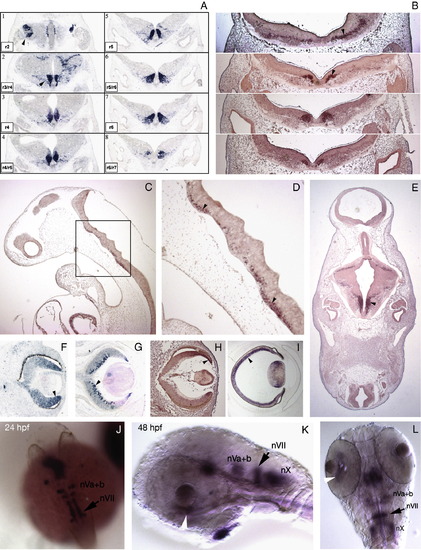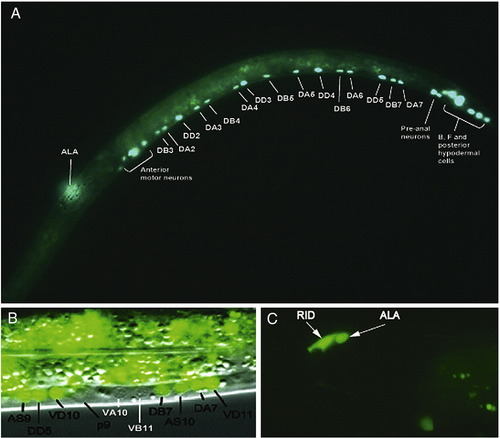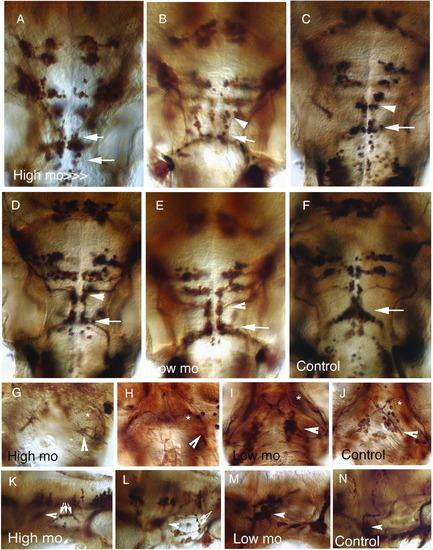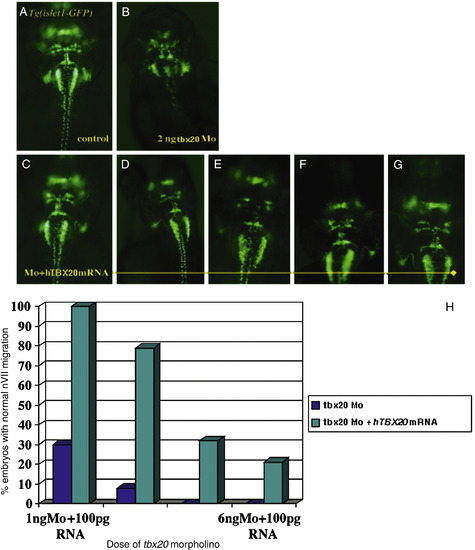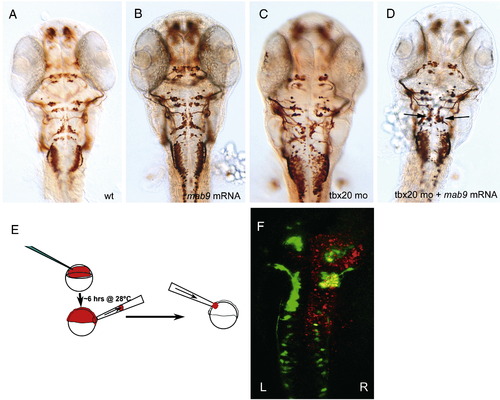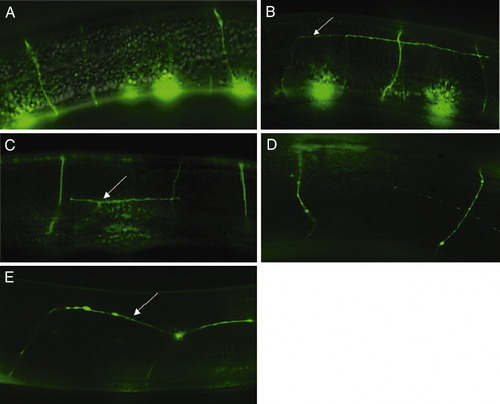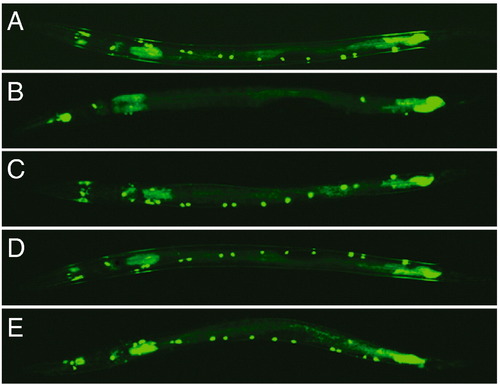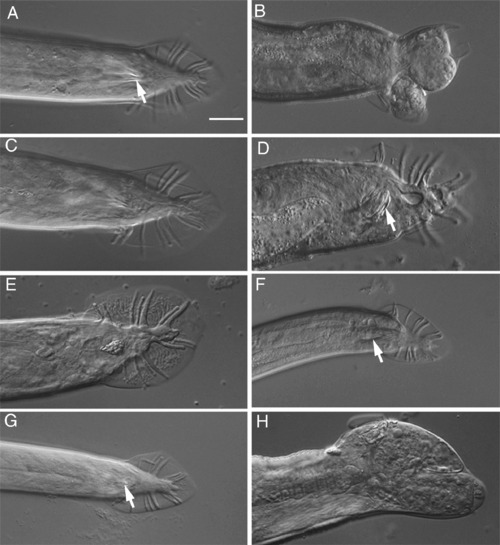- Title
-
Neuronal function of Tbx20 conserved from nematodes to vertebrates
- Authors
- Pocock, R., Mione, M., Hussain, S., Maxwell, S., Pontecorvi, M., Aslam, S., Gerrelli, D., Sowden, J.C., and Woollard, A.
- Source
- Full text @ Dev. Biol.
|
Expression of vertebrate Tbx20 orthologues. (A) Tbx20 expression in E11.5 mouse hindbrain in dorsolaterally migrating trigeminal motor neurons (plate 1; arrowhead) and caudo-laterally migrating facial motor neurons (plates 2–8; arrowhead) in transverse sections at the level of rhombomeres (r) 2 to 7. (B–E) TBX20 expression in migrating motor neurons in the hindbrain of human embryos (arrowheads). (B) Series of rostral to caudal transverse sections through the hindbrain at 120-μm intervals, CS15, 33 days. (C, D) CS13, 28 days. (E) CS16, 37 days. Panel D shows high magnification view of boxed area in panel C. (F–I) TBX20/Tbx20 expression in mouse and human neural retina (arrowheads). (F) E11.5 (mouse). (G) E15.5 (mouse). (H) CS16, 37 days (human). (I) fetal stage 2, 63 days (human). (J–L) tbx20 expression in cranial motor neurons in zebrafish embryos at 24 (J) and 48 hpf (K, L). Black arrows indicate facial motor neurons (nVII). Trigeminal motor neurons (nVa + b) and vagal motor neurons (nX) are also shown. White arrowheads in panels K and L indicate retinal neurons. |
|
Expression of tbx-20/mab-9 in C. elegans. (A) L1 larva containing the genomic rescuing mab-9::GFP reporter pAW118 (Woollard and Hodgkin, 2000). Nuclear MAB-9 expression is detected in all embryonically-derived motor neurons (DA, DB and DD). Expression is also observed in a head neuron (out of focal plane), B and F rectal epithelial cells and posterior hypodermal cells of the tail, as previously reported (Woollard and Hodgkin, 2000). (B) Expression of mab-9::GFP is detected in post-embryonically derived AS and VD motor neurons in addition to embryonically derived DA, DB and DD motor neurons. No mab-9::GFP expression is observed in VA and VB motor neurons. C: mab-9::GFP expression in the head region of an animal also expressing ceh-10::GFP (which is only expressed in RID and not ALA in this particular integrant (lqIs4); Oliver Hobert, pers. comm.). Two nuclei are clearly visible (labelled RID and ALA), with MAB-9 in a nucleus just posterior to RID. This confirms its identity as ALA. Dorsal is up, posterior to the right in all panels. |
|
Cranial motor neuron migration defects in zebrafish embryos. (A–E) 48 hpf tg(isl1:GFP) zebrafish embryos injected with decreasing amounts of tbx20 morpholino. (A) 6 ng per embryo, (B) 4 ng per embryo, (C) 3 ng per embryo, (D) 2 ng per embryo, (E) 1 ng per embryo. Dorsal views of the hindbrain, rostral is to the top. Migration defects of the nVII motor neurons (white arrowheads) that only partially reach rhombomere 6 (white arrows). (F) Uninjected control. (G–I) 5 dpf tg(isl1:GFP) zebrafish embryos injected with decreasing amount of tbx20 morpholino. Ventral views, dorsal to the top, showing the trigeminal (asterisk) and facial nerve (arrowheads). Only the facial nerves show severe pathfinding defects. (J) Uninjected control. (K–M) 5 dpf tg(isl1:GFP) zebrafish embryos injected with decreasing amount of tbx20 morpholino. Lateral views, rostral to the left. Arrowheads point to the facial sensory ganglion and adjacent facial nerve, displaying growing defects. Small white arrows point to the anterior lateral line nerve, which is not affected by tbx20 morpholino injections. (N) Uninjected control. |
|
Rescue of zebrafish cranial motor neuron migration defects with human TBX20 mRNA. (A, B) 48 hpf tg(isl1:GFP) zebrafish embryos. (A) Uninjected control. (B) Embryo treated with 2 ng of tbx20 morpholino. (C–G) Embryos injected with 2 ng of tbx20 morpholino show rescue of the neuronal migration phenotype following injections of mRNA (from 50 to 250 pg/embryo increasing from panels C to G in 50 pg increments) encoding HsTBX20. Abnormal migration of nV and nVII motor neuron soma visualized in tg(islet1::GFP) embryos (B) is reverted by co-injection of mRNA for HsTBX20. (H) Percentage of tg(isl1:GFP) embryos (Y axis) showing normal migration of nVII motor neurons following co-injection of increasing (1, 2, 4, 6 ng) doses of tbx20 Mo (X axis) with 100 pg mRNA encoding HsTBX20. EXPRESSION / LABELING:
|
|
Rescue of cranial nerve migration defects with C. elegans mab-9 mRNA and cell autonomous function of tbx20 in cranial motor neurons. (A–D) 48 hpf tg(islet1:GFP) zebrafish embryos, dorsal views. (A) Uninjected control; (B) embryo injected with 100 pg mab-9 mRNA; (C) embryo injected with 2 ng tbx20 morpholino; (D) embryo injected with mab-9 mRNA and tbx20 morpholino. A partial rescue of the migration defect of nVII neurons is observed in panel D (black arrows). Quantification of the rescue data is shown in Supplementary Table 2. (E) Diagram illustrating the transplantation procedure (see text for details). (F) Cells loaded with tbx20 morpholino and rhodamine dextran are unable to migrate to rhombomere 6 (right side) unlike their counterparts in the host (left side). EXPRESSION / LABELING:
|
|
mab-9 mutants have motor neuron axon guidance defects. (A) WT adult hermaphrodite carrying an unc-25::GFP reporter specific for DD/VD GABAergic neurons). Motor neuron cell bodies are located in the ventral nerve cord. Commissures extend around the circumference of the worm, 17 of which run on the right hand side with 2 running on the left hand side. As the commissures reach the dorsal side they bifurcate to form the dorsal nerve cord (out of focal plane). (B and C) Adult mab-9(e2410) animals carrying the unc-25::GFP reporter. DD/VD motor neurons extend circumferential commissures that are misguided. (B) Misguided commissure stalling at the ventral side of dorsal muscle (arrow). (C) Misguided commissure stalling at the lateral nerve cord (arrow). Misguided axons often cross a number of adjacent commissures. (D) WT adult hermaphrodite carrying an unc-53::GFP reporter, expressed in DA and AS motor neurons. Again, commissures can be seen to extend around the circumference of the worm. (E) Adult mab-9(e2410) adult carrying the unc-53::GFP reporter. Misguided DA/AS motor neurons are visible (arrow). Dorsal is up, posterior to the right in all panels. |
|
Human Tbx20 T-box domain can functionally substitute for mab-9. (A) WT hermaphrodite carrying the evIs82b unc-129::GFP reporter, expressed in DA and DB motor neurons plus other neurons in the head and tail. (B) mab-9(e2410) animal carrying the unc-129::GFP reporter. The expression of unc-129::GFP is specifically reduced in motor neurons and is only observed very weakly in a couple of neurons at the anterior and posterior. (C) mab-9(e2410) animal carrying the genomic mab-9 construct pAW118 as well as the unc-129::GFP reporter. Complete rescue of the unc-129::GFP neuronal expression defect is observed, with the animal looking very similar to WT. (D) mab-9(e2410) animal carrying the mab-9 minigene construct pAW230 (ouEx63) in addition to the unc-129::GFP reporter. Again, complete rescue of the unc-129::GFP neuronal expression defect is observed. (E) mab-9(e2410) animal carrying the mab-9/HsTBX20 chimeric minigene construct pAW271 (ouEx62) as well as the unc-129::GFP reporter. Complete rescue of the neuronal phenotype is again observed. Typical phenotypes are shown. Posterior is to the right on all panels. |
|
Human Tbx20 T-box domain also rescues male tail defects in mab-9 animals. (A) him-8(e1489) male tail (effectively WT). The cuticular fan containing embedded sensory rays is evident at the posterior and the refractile spicules are clearly visible (arrow). (B) mab-9(e2410); him-8(e1489) male tail. Male tail morphogenesis is grossly abnormal and no spicules are evident. (C) mab-9(e2410); him-8(e1489) male completely rescued with the mab-9 genomic construct pAW118 (carried as an extrachromosomal array). (D) mab-9(e2410); him-8(e1489) male carrying the full length mab-9 cDNA construct pAW141 (ouEx71). Rescue is incomplete, with morphogenetic defects apparent in the fan and very abnormal spicules (arrow). (E) mab-9(e2410); him-8(e1489) male carrying the full length human TBX20 construct pAW175 (ouEx70). Again, rescue is incomplete with aberrant fan morphogenesis and grossly abnormal spicules. (F) mab-9(e2410); him-8(e1489) male carrying the mab-9 minigene construct pAW230 (ouEx63). Good rescue is observed, with the fan looking normal and well formed spicules evident (arrow), much like in panels A and C. (G) mab-9(e2410); him-8(e1489) male carrying the mab-9/HsTBX20 minigene constuct pAW271 (ouEx62), in which the entire T-box domain of mab-9 is replaced with the human Tbx20 T-box domain. Rescue is good, with well formed fan and spicules (arrow). (H) mab-9(e2410); him-8(e1489) male carrying the mab-9/Xbra chimeric minigene construct pAW294 (ouEx73). No rescue is observed. Gross morphological defects are observed and there is no evidence of spicule formation, much like in panel B. Typical phenotypes are shown. Posterior is to the right in all panels. Scale bar, 25 μm. |
Reprinted from Developmental Biology, 317(2), Pocock, R., Mione, M., Hussain, S., Maxwell, S., Pontecorvi, M., Aslam, S., Gerrelli, D., Sowden, J.C., and Woollard, A., Neuronal function of Tbx20 conserved from nematodes to vertebrates, 671-685, Copyright (2008) with permission from Elsevier. Full text @ Dev. Biol.

